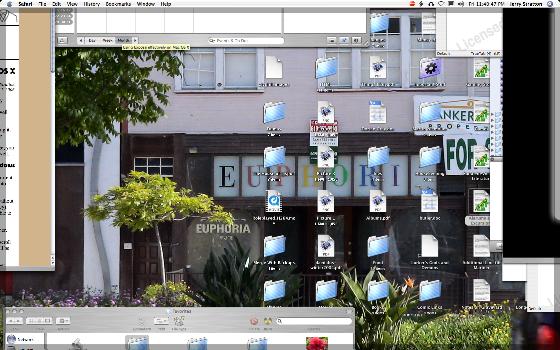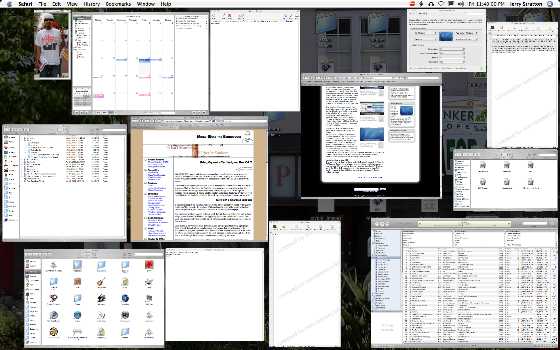Using Exposé effectively on Mac OS X
Mac OS X 10.3 brought with it a new feature called Exposé that allows you to quickly switch to any open window. But it also allows a lot more. Judging from the way I see people work, some of the basic window management features on Mac OS X are not well known.
Work with background windows
Is there something in the back that you need to see, but it’s partially obscured by the current application? For example, do you have a Wikipedia article open while you're typing into your word processor, and you’d like to see more of the Wikipedia web page?
You can move windows around, and even scroll through them and adjust their size, without bringing them forward. Hold down the Apple key (sometimes called the Command key). Click on a background window’s title bar. It will not come forward, but you will be able to drag it around.
Does it need to be widened? Hold down the Apple key and grab the bottom right corner. Need to scroll through a long e-mail message or web page that you’re keeping in the background? Again, not a problem. Hold down the Apple key and either click in the scroll bar of that background window, or grab the scroll indicator and move it around. You’ll be able to scroll through the window’s contents without bringing it forward.
Smart applications won’t come forward no matter where you click them, but some other applications will. No application should come forward, however, if you grab it on its title bar. Most Apple applications will support all of that: Mail, Safari, and iCal, among the applications I currently have open, do, though iTunes only supports dragging the title bar.
If you do a lot of typing or drawing from other sources, Apple-clicking background windows is a very useful tool.
Drag from the desktop
You probably know that you can drag items from the Desktop or other Finder windows and into open applications. If your screen is filled with open windows, however, you usually can’t see any of the items on your Desktop in order to grab them. Hit the F11 key, and all open windows will slide off to the sides, leaving your Desktop, and all its treasures, available.
So, hit F11, grab the file you want, hit F11 again, and drop the file into your current window.

All open windows slide up, down, right, and left to show the items on the desktop.
Drag from any open window
Often, though, the item you want won’t be on your desktop. You’ll have opened a couple of Finder windows and the item you want is in one of them. Hit F9, and all open windows shrink so that all of them are visible.
To drag something from one window to another, hit F9, choose the window you want, grab the item you want, hit F9, choose the window you want to drag to, hit F9, and let go.
You don’t even have to hit F9 the second time. Just hover the item you’re dragging over the desired window for a few seconds and that window will come to the front.

Exposé shows all open windows for easily transferring stuff from one window to another.
Jump to an open folder while saving
Often, I find myself working on original images from one folder while working on a folder full of web pages. When I go to save the image for the web, GraphicConverter wants to save into the image’s original folder, not the web page folder.
The “save” window has become much easier to use over recent revisions of OS X, but I still end up having to browse up and down levels of folders to get to the place I want. But Apple-click or F9 make this easier when the folder I want to save into is in an open Finder window.
- Go to “Save as…”.
- If you can’t see the folder you want to save into, use F9 to choose it.
- If you can’t see the folder icon in the middle of that folder’s title bar, use the Apple key and the mouse to move the middle of the title bar into view.
- Hold down the mouse button over the blue folder icon in that folder’s title bar. Hold it down for a count of about three, until you can see the folder icon darken. You can now drag it around. (Use the Apple key in conjunction with this or not, depending on whether you care that the Finder window will come to the front.)
- Drag that Folder icon to the “Save as…” window that you wish were pointing to that folder. You may have to use F9 to bring it forward.
- Drop the folder icon onto the “Save as…” window. That window will immediately switch to that folder.
Once you’ve done that once, the application will usually remember that folder in the “Recent Places” area of the “Save as…” window.
The next time you have a lot of open windows, take a few minutes to play around with these features, and see how useful they can be to you.
- Exposé
- “Instantly access any open window with a single keystroke—and stunning style that can never be imitated. Display all open windows as thumbnails, view windows of the current application or hide all windows to quickly locate a file on your desktop.”
More macOS tricks
- 42 Astoundingly Useful Scripts and Automations for the Macintosh
- MacOS uses Perl, Python, AppleScript, and Automator and you can write scripts in all of these. Build a talking alarm. Roll dice. Preflight your social media comments. Play music and create ASCII art. Get your retro on and bring your Macintosh into the world of tomorrow with 42 Astoundingly Useful Scripts and Automations for the Macintosh!
- Save clipboard text to the current folder
- Use the Finder toolbar to save text on the current clipboard directly to a file in the folder that Finder window is displaying.
- Avoiding lockFocus when drawing images in Swift on macOS
- Apple’s recommendation is to avoid lockFocus if you’re not creating images directly for the screen. Here are some examples from my own Swift scripts. You can use this to draw text into an image, and to resize images.
- What app keeps stealing focus?
- I’ve been having a problem on Mac OS X with something stealing focus. Here’s how to at least find out what that something is.
- Enable AirPrint for all connected Mac printers
- I have an iPad and an old workhorse of a printer, an HP 1012 LaserJet, connected to my iMac. I almost never need to print from the iPad, but when I do, handyPrint works.
- 14 more pages with the topic macOS tricks, and other related pages

